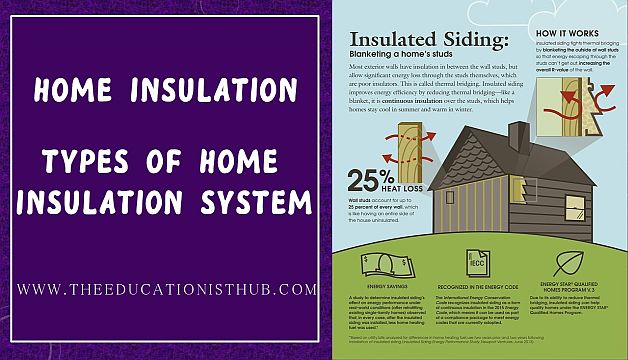Last Updated on: 26th June 2023, 05:48 am
What is Home Insulation System And its Types?
In this article, we will discuss the Home Insulation System and its types. Home Insulation System is very essential to control the hot and cold environment in our home.
An accurate home insulation system can also save you a lot of expenses from insulation costs in the summer and cold seasons.
If we look at the statistics on home insulation, here’s something like this:
Insulation Costs At Your Home
■ On average, keeping a home hot or cool costs almost 54% of annual utility bills.
■ Wall insulation can reduce heat or cold by 76% while roof insulation can reduce heat and cold costs by up to 40%.
■ If your roof is not insulated then the cost of keeping it cool increases by 10%.
■ Due to the insulation of basement walls or slab foundations, the cost of reducing heat can be decreased by 10% to 20%.
How Your Home Gets Warm?
These are the factors on which your home warming depends:
■ 26% of the heat emerges through the roof.
■ 33% of the heat comes through walls.
■ 8% of heat is from the floor.
■ 3% of heat blows out from the door holes.
■ 18% of the heat comes from the windows.
■ 12% of heat comes from light grains, etc.
Types Of Insulation
There are four common types of Insulation, which can increase or decrease the heat in your home, depending on the weather outside the home.
1. Spray Foam Home Insulation
This type of insulation is carried out with the help of spray holders for which containers are used at certain home locations. The best places for spray foam insulation are new wall spaces, unfinished ceilings, or existing walls.
Although the foam is done with a spray holder, it can also be applied in large quantities in a foamed-in-place manner. In the market different spray foam, insulation kits are available like Foam It Green 602 Closed Cell, Dow Froth Pak 650, and others.
It is important to keep in mind that spray foam insulation is a bit expensive. Plus, it also gets a lot of mess.
Since it is made of chemicals, the patient may have difficulty breathing while using it. Therefore, it is advisable to hire experienced experts for this work so that spray foam is applied everywhere at the same level.
2. Fiberglass Home Insulation
This is the most common type of insulation, which is applied in stitches or spaces. Its biggest feature is that it is not only cheaper but also has the easiest insulation for homes and it does not affect the home.
Another benefit of fiberglass is that it doesn’t generate fire and your home is safe. That is why most people prefer fiberglass home insulation systems.
This insulation is done between beads, beams, and poles, but it is important to take care when installing as it may affect your lungs or skin during installation.
That is why you should stay away from it when insulation is being performed. Fiberglass shrinks over time, so it has to be re-applied periodically.
3. Mineral Wool Home Insulation
Mineral wool insulation is also called rock wool insulation. It is similar to fiberglass and easy to apply. It comes in bags and is poured directly into specific places.
It also tolerates high temperatures and even tolerates temperatures of up to a thousand degrees compared to other types of insulation. After insulation from mineral wool, the house is also soundproof.
It is slightly more expensive than fiberglass and is not readily available in the market. It is important to take protective measures when applying it otherwise its particles may damage your lungs.
4. Cellulose Home Insulation
Cellulose insulation is the best choice for you if you are looking for an in-house method of insulation for your home.
This type of insulation is mostly made from recycled papers, especially newspapers and occasionally cardboard and other types of paper.
It is then incorporated into the insulation by Material Chemicals. This insulation protects the house from moisture, heat, and insects.
It is important to remember that cellulose insulation starts to deteriorate over time due to the absorption of moisture. That is why experts recommend that this insulation must be repeated every 5 years.
In addition, cellulose home insulation is much more expensive than conventional fiberglass home insulation and spreads a lot of dust during its installation. If this insulation is dry or wet, you should cover your nose at the time of this installation.
5. The Formula To Find Better Insulation Material
The R-value formula is followed to determine the best insulation measurement. Based on the R-value, it is determined how much heat the material is able to absorb or remove.
The higher the R-value of the material, the better it is for insulation, such as Polyisocyanurate’s R-value is 7.2, and of fiberglass, glass is 4, so Polyisocyanurate is much better. For complete detail regarding R-Value, Read this Article.
More Tips For Heat Loss
■ Apply Heavy curtains on windows, which do not allow outside heating or cooling inside.
■ Apply excellent quality exhaust fan at home and especially in kitchens, which supports your home insulation system by throwing the heat out.
■ Close the holes in the door, so as no hot air get inside the windows if there is any hot air outside.

Researcher, Blogger, Content Writer, Online Marketing Expert, Aptitude Test & Admissions Expert, Career Counselor.
PEC REGISTERED. ENGINEER. (NED University of Engineering & Technology)
CEO / Founder (The Educationist Hub)



